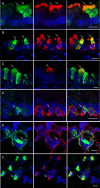Preparation for a first-in-man lentivirus trial in patients with cystic fibrosis
- PMID: 27852956
- PMCID: PMC5284333
- DOI: 10.1136/thoraxjnl-2016-208406
Preparation for a first-in-man lentivirus trial in patients with cystic fibrosis
Abstract
We have recently shown that non-viral gene therapy can stabilise the decline of lung function in patients with cystic fibrosis (CF). However, the effect was modest, and more potent gene transfer agents are still required. Fuson protein (F)/Hemagglutinin/Neuraminidase protein (HN)-pseudotyped lentiviral vectors are more efficient for lung gene transfer than non-viral vectors in preclinical models. In preparation for a first-in-man CF trial using the lentiviral vector, we have undertaken key translational preclinical studies. Regulatory-compliant vectors carrying a range of promoter/enhancer elements were assessed in mice and human air-liquid interface (ALI) cultures to select the lead candidate; cystic fibrosis transmembrane conductance receptor (CFTR) expression and function were assessed in CF models using this lead candidate vector. Toxicity was assessed and 'benchmarked' against the leading non-viral formulation recently used in a Phase IIb clinical trial. Integration site profiles were mapped and transduction efficiency determined to inform clinical trial dose-ranging. The impact of pre-existing and acquired immunity against the vector and vector stability in several clinically relevant delivery devices was assessed. A hybrid promoter hybrid cytosine guanine dinucleotide (CpG)- free CMV enhancer/elongation factor 1 alpha promoter (hCEF) consisting of the elongation factor 1α promoter and the cytomegalovirus enhancer was most efficacious in both murine lungs and human ALI cultures (both at least 2-log orders above background). The efficacy (at least 14% of airway cells transduced), toxicity and integration site profile supports further progression towards clinical trial and pre-existing and acquired immune responses do not interfere with vector efficacy. The lead rSIV.F/HN candidate expresses functional CFTR and the vector retains 90-100% transduction efficiency in clinically relevant delivery devices. The data support the progression of the F/HN-pseudotyped lentiviral vector into a first-in-man CF trial in 2017.
Keywords: Cystic Fibrosis.
Published by the BMJ Publishing Group Limited. For permission to use (where not already granted under a licence) please go to http://www.bmj.com/company/products-services/rights-and-licensing/.
Conflict of interest statement
Conflicts of Interest: None declared.
Figures







Similar articles
-
Pharmacological and pre-clinical safety profile of rSIV.F/HN, a hybrid lentiviral vector for cystic fibrosis gene therapy.Eur Respir J. 2025 Jan 30;65(1):2301683. doi: 10.1183/13993003.01683-2023. Print 2025 Jan. Eur Respir J. 2025. PMID: 39174284 Free PMC article.
-
Assessment of F/HN-pseudotyped lentivirus as a clinically relevant vector for lung gene therapy.Am J Respir Crit Care Med. 2012 Nov 1;186(9):846-56. doi: 10.1164/rccm.201206-1056OC. Epub 2012 Sep 6. Am J Respir Crit Care Med. 2012. PMID: 22955314 Free PMC article.
-
Lentiviral Gene Therapy for Cystic Fibrosis: A Promising Approach and First-in-Human Trial.Am J Respir Crit Care Med. 2024 Dec 15;210(12):1398-1408. doi: 10.1164/rccm.202402-0389CI. Am J Respir Crit Care Med. 2024. PMID: 39236265 Free PMC article. Review.
-
Long-term therapeutic and reporter gene expression in lentiviral vector treated cystic fibrosis mice.J Gene Med. 2014 Sep-Oct;16(9-10):291-9. doi: 10.1002/jgm.2778. J Gene Med. 2014. PMID: 25130650
-
Lentiviral Vectors for the Treatment and Prevention of Cystic Fibrosis Lung Disease.Genes (Basel). 2019 Mar 14;10(3):218. doi: 10.3390/genes10030218. Genes (Basel). 2019. PMID: 30875857 Free PMC article. Review.
Cited by
-
Functional restoration of a CFTR splicing mutation through RNA delivery of CRISPR adenine base editor.Mol Ther. 2023 Jun 7;31(6):1647-1660. doi: 10.1016/j.ymthe.2023.03.004. Epub 2023 Mar 9. Mol Ther. 2023. PMID: 36895161 Free PMC article.
-
The revolution of personalized pharmacotherapies for cystic fibrosis: what does the future hold?Expert Opin Pharmacother. 2023 Sep-Dec;24(14):1545-1565. doi: 10.1080/14656566.2023.2230129. Epub 2023 Jul 3. Expert Opin Pharmacother. 2023. PMID: 37379072 Free PMC article.
-
Pulmonary gene delivery-Realities and possibilities.Exp Biol Med (Maywood). 2021 Feb;246(3):260-274. doi: 10.1177/1535370220965985. Epub 2020 Nov 12. Exp Biol Med (Maywood). 2021. PMID: 33183069 Free PMC article. Review.
-
Lung-targeting lentiviral vector for passive immunisation against influenza.Thorax. 2020 Dec;75(12):1112-1115. doi: 10.1136/thoraxjnl-2020-214656. Epub 2020 Sep 3. Thorax. 2020. PMID: 32883885 Free PMC article.
-
On the Corner of Models and Cure: Gene Editing in Cystic Fibrosis.Front Pharmacol. 2021 Apr 27;12:662110. doi: 10.3389/fphar.2021.662110. eCollection 2021. Front Pharmacol. 2021. PMID: 33986686 Free PMC article. Review.
References
Publication types
MeSH terms
Substances
Grants and funding
LinkOut - more resources
Full Text Sources
Other Literature Sources
Medical
